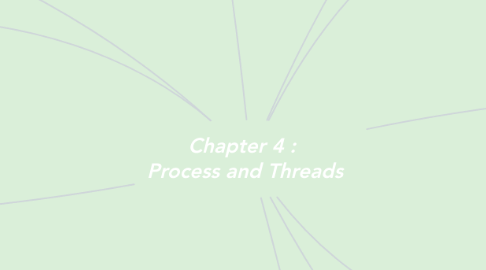
1. OS Management of Application Execution
1.1. Resources are made available to multiple applications
1.2. The processor and I/O devices can be used efficiently
2. Process
2.1. Fundamental to the structure of operating systems
2.2. Two essential elements of a process are:
2.2.1. Program code
2.2.2. A set of data associated with that code
2.3. While the program is executing, this process can be uniquely characterized by a number of elements.
2.4. Process Control Block
2.4.1. Contains the process elements
2.4.2. Created and managed by the operating system
2.4.3. Key tool that allows support for multiple processes
3. Processes and Threads
3.1. Resource Ownership
3.1.1. Process includes a virtual address space to hold the process image
3.2. Scheduling/Execution
3.2.1. Follows an execution path that may be interleaved with other processes
3.3. 1. The unit of dispatching is referred to as a thread or lightweight process. 2. The unit of resource ownership is referred to as a process or task. 3.Multithreading - The ability of an OS to support multiple, concurrent paths of execution within a single process.
4. Threads
4.1. Single Threaded Approaches
4.1.1. the concept of a thread is not recognized, is referred to as a single-threaded approach.
4.2. Multithreaded Approaches
4.3. Benefit
4.3.1. Takes less time to create a new thread than a process.
4.3.2. Less time to terminate a thread than a process.
5. Processes
5.1. Protected access to:
5.1.1. 1. processors 2. other processes 3. files 4. I/O resources
6. Process Termination
6.1. There must be a means for a process to indicate its completion
6.2. A batch job should include a HALT instruction or an explicit OS service call for termination
7. Process Creation
7.1. Occurs when a new process is to be added to those currently being managed processes
7.2. Process spawning
7.3. Parent process
7.4. Child process
8. Two-State Process Model
8.1. Running
8.2. Not-Running
9. Process States
9.1. Trace
9.1.1. listing the sequence of instructions that execute for that process
9.1.2. showing how the traces of the various processes are interleaved
9.2. Dispatcher
9.2.1. switches the processor from one process to another
10. Suspended Processes
10.1. Swapping
10.1.1. involves moving part of all of a process from main memory to disk
10.2. Characteristics of a Suspended Process
10.2.1. The process is not immediately available for execution
10.2.2. The process may or may not be waiting on an event

